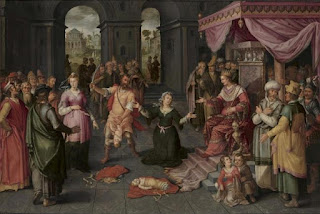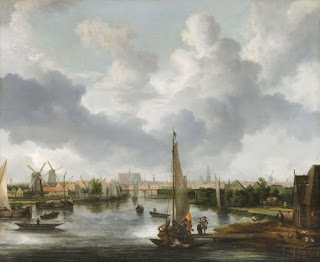Like the Spring gave me sudden burst of energy, immediately very next day I accepted the suggestion to visit nearby Alkmaar and its local municipal museum. I have been to Alkmaar before, it is one of these picturesque little towns surrounding Amsterdam, where quiet life, serene atmosphere and cheerful faces reflect lack of the stress associated with tourist attack like in Amsterdam - people are always, without exception, far more happier and curious in smaller places than in big cities where elbowing is the rule. This particular museum was on my mind for quite some time so I was really excited to visit and the day was just magnificent.It is a very modern building (somehow forced upon quaint medieval square next to spectacular Sint-Laurenskerk) situated on so called "the culture square" because the spiritual life of the city is all here - next to the church are also library and the theatre. To be honest, current use is far better than what is used to be before - a parking lot. So instead of having a parking lot there, now its a lot of interesting subjects - in fact, I probably wouldn't even mind living there, it feels a lot less stressful than in Amsterdam where passersby often radiate menace.
The very first part of the museum is all about the history so called "the Siege of Alkmaar" when local citizens fought mighty Spanish army and was in fact the very first Dutch city to repel Spaniards. That was one of the most important dates in revolt of Dutch provinces against Philip II of Spain who claimed ownership of the whole territories (the same Philip who was married to childless Mary Stewart - her younger sister and inheritor was Elizabeth I) and here is where Spanish hold started to slip. To be honest, locals fought bravely but it was William of Orange who came to help, with his orders to break the surrounding dikes and this forced Spanish out of flooded area. I would say 50/50 for both Alkmaar bravery and William himself. It was very exciting time and they have every reason to be proud of it. As a part of the exhibition there are several very interesting letters, diaries and portraits from that time. There is also a story about 16 year old brave girl Trijn Rembrants who fought bravely and became a legend. Today she is remembered with affection more as a symbol than a real person and in fact we are not exactly sure did she really exist or was it combination of several people somehow rolled into one - what is for sure is that women of besieged Alkmaar fought aside their men heroically.
There were also some genuinely beautiful old paintings - I loved the portrait of local businessman Dirck van Os who eventually rose to became real tycoon of his time and one of the main investors of Dutch East India Company that will soon change the history of the whole country and made The Netherlands into world power. Lots of historical glassware and furniture and - best of all - a surreal paining called "Witches’ Sabbath" by Dutch painter Claes Jacobsz. van der Heck who was obviously inspired by much earlier and completely mysterious Hieronymus Bosch - it is a kind of painting that one could gaze the whole afternoon and still find new details. (Come to think of it, so can you with all those paintings depicting skaters on ice) Next to it is another painting by same artist - "The judgement of Solomon" which is perfectly fine and beautifully done, but this time without the nightmare fantasy.
The upper floor was all about the modern art and something called The Bergen School - all about expressionists Dutch artists who created art between 1915 and 1925 - interesting how tumultuous times seem to inspire artists much more than quiet and peaceful times. At first I thought this might be too modern for my conservative taste (also just coming from downstairs and all that different style of beauty) but to my biggest surprise I really liked what I saw - obviously I am changing as well, perhaps because I worked on it and exposed myself to so many different museums that some of it has rubbed on me. Its actually quite interesting how a person can educate himself despite coming from a completely non-nurturing background (nobody around me during the childhood ever cared a fig about art, history, music or literature).
There was also a temporary exhibition dedicated to local painter Allart van Everdingen who became world known for his arty landscapes of rough Norvegian and Swedish coastlines. This exhibition was quite magical and we all loved the huge paintings with massive skies, thunderous waterfalls, windmills and the whole shebang, but personally I found the biggest surprise were his little sketches, probably originally made as a study for later much bigger paintings and I was so thrilled with their perfection that I was constantly pulling my companions to have a look again at them. These sketches were a sharp contrast to his huge, majestic landscapes that were obviously created to amaze and impress the visitors of some magnificent buildings - the sketches were not bigger than a matchbox and were extremely detailed and lovingly created. I am really impressed with the art of miniature.


























